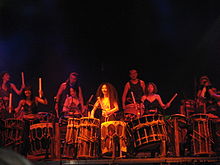
Back Slaginstrument Afrikaans Schlaginstrument ALS آلة إيقاعية Arabic Instrumentu de percusión AST Zərb musiqi alətləri Azerbaijani Ударныя музычныя інструменты Byelorussian Ударен музикален инструмент Bulgarian ঘাতযন্ত্র Bengali/Bangla Benveg-tosiñ Breton Instrument de percussió Catalan
This article includes a list of general references, but it lacks sufficient corresponding inline citations. (March 2019) |







A percussion instrument is a musical instrument that is sounded by being struck or scraped by a beater including attached or enclosed beaters or rattles struck, scraped or rubbed by hand or struck against another similar instrument. Excluding zoomusicological instruments and the human voice, the percussion family is believed to include the oldest musical instruments.[1] In spite of being a very common term to designate instruments, and to relate them to their players, the percussionists, percussion is not a systematic classificatory category of instruments, as described by the scientific field of organology. It is shown below that percussion instruments may belong to the organological classes of idiophone, membranophone, aerophone and chordophone.
The percussion section of an orchestra most commonly contains instruments such as the timpani, snare drum, bass drum, tambourine, belonging to the membranophones, and cymbals and triangle, which are idiophones. However, the section can also contain aerophones, such as whistles and sirens, or a blown conch shell. Percussive techniques can even be applied to the human body itself, as in body percussion. On the other hand, keyboard instruments, such as the celesta, are not normally part of the percussion section, but keyboard percussion instruments such as the glockenspiel and xylophone (which do not have piano keyboards) are included.
Percussion instruments are most commonly divided into two classes: pitched percussion instruments, which produce notes with an identifiable pitch, and unpitched percussion instruments, which produce notes or sounds in an indefinite pitch.[2][failed verification][3][failed verification]
- ^ The Oxford Companion to Music, 10th edition, p.775, ISBN 0-19-866212-2
- ^ "Instruments: Philharmonia Orchestra". Philharmonia.co.uk. Archived from the original on 2013-07-22. Retrieved 2015-03-30.
- ^ "Percussion — Musical Instruments at your Fingertips". www.miayf.org. Archived from the original on July 4, 2015.
© MMXXIII Rich X Search. We shall prevail. All rights reserved. Rich X Search